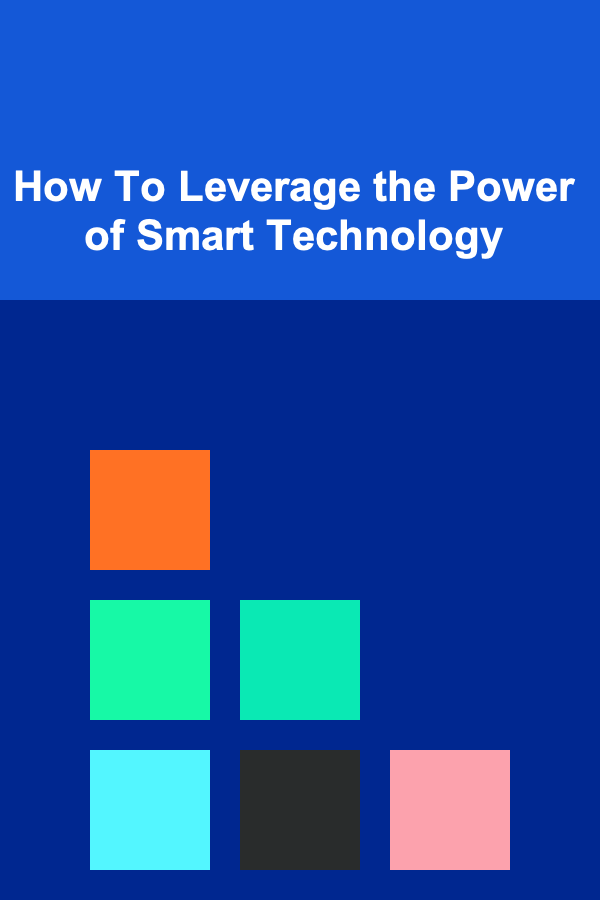
How To Leverage the Power of Smart Technology
ebook include PDF & Audio bundle (Micro Guide)
$12.99$6.99
Limited Time Offer! Order within the next:

In today's fast-paced, interconnected world, smart technology is revolutionizing the way we live, work, and interact with our surroundings. From smart homes and devices to industrial automation and healthcare, these innovations promise to simplify processes, increase efficiency, and provide valuable insights that can enhance the quality of life. However, in order to fully harness the potential of smart technology, individuals, businesses, and industries must understand its capabilities, integrate it strategically, and consider the ethical and practical implications.
Understanding Smart Technology
Smart technology refers to devices, systems, and applications that utilize advanced technologies such as artificial intelligence (AI), machine learning, sensors, the Internet of Things (IoT), and cloud computing to perform tasks autonomously or semi-autonomously. These technologies allow devices to collect, analyze, and respond to data in real-time, enabling them to make decisions without human intervention or with minimal input.
At the core of smart technology is the ability to collect and process vast amounts of data. This data can come from various sources---whether it's sensors embedded in devices, real-time information from users, or patterns detected by machine learning algorithms. The power of smart technology lies not only in its ability to collect this data but also in its capacity to turn this data into actionable insights.
Applications of Smart Technology
1. Smart Homes
One of the most recognizable applications of smart technology is in the domain of smart homes. Devices such as smart thermostats, lights, locks, and security cameras are powered by IoT technology. These devices are interconnected and can be controlled remotely via smartphones or voice assistants, such as Amazon Alexa or Google Assistant.
Energy Efficiency and Convenience
Smart thermostats like Nest learn your habits and adjust your home's temperature accordingly, reducing energy consumption while maximizing comfort. Lighting systems can be programmed to turn off automatically when rooms are unoccupied or adjust their intensity based on natural light, saving electricity.
Smart homes also improve convenience by allowing homeowners to control various systems from a single interface. Whether it's adjusting the thermostat, dimming the lights, or locking doors, these tasks can be performed through an app, voice commands, or even automation based on time or proximity.
Home Security and Safety
Smart home technology also plays a significant role in enhancing security and safety. Cameras, motion detectors, and smart locks provide homeowners with real-time video feeds, alerts about unusual activity, and the ability to control their doors remotely. This makes it easier to monitor their homes from anywhere in the world.
2. Healthcare and Medicine
Smart technology is also making a transformative impact in the healthcare sector. Devices like wearable fitness trackers, remote health monitoring systems, and telemedicine platforms are giving individuals more control over their health while also enhancing healthcare providers' ability to offer timely care.
Remote Monitoring and Telemedicine
Wearable devices like smartwatches can track vital signs such as heart rate, blood oxygen levels, and even detect early signs of potential health issues. Remote health monitoring solutions enable doctors to continuously track patients' conditions without requiring them to visit the clinic regularly.
Telemedicine, powered by smart technology, allows patients to consult healthcare professionals remotely, reducing wait times and improving access to care, especially for those in rural or underserved areas.
Artificial Intelligence in Diagnostics
AI-powered diagnostic tools have shown great promise in assisting doctors with early detection of diseases. For instance, machine learning algorithms can analyze medical images---such as X-rays, MRIs, and CT scans---faster and often more accurately than human doctors, enabling earlier diagnoses and more effective treatments.
3. Smart Manufacturing and Industry 4.0
Smart technology is driving the fourth industrial revolution, also known as Industry 4.0. In manufacturing, automation, robotics, and IoT sensors are revolutionizing production processes, improving efficiency, and enhancing safety.
Predictive Maintenance
One of the key areas where smart technology is making an impact is in predictive maintenance. By using IoT sensors and AI algorithms to monitor equipment performance in real time, manufacturers can predict when a machine is likely to fail. This allows them to perform maintenance before a breakdown occurs, minimizing downtime and reducing repair costs.
Supply Chain Optimization
Smart technology also improves the efficiency of supply chains by providing real-time visibility into inventory, shipments, and production schedules. IoT-enabled devices and smart sensors collect data that is then processed to optimize inventory levels, reduce waste, and ensure the timely delivery of products. Automated systems in warehouses can also improve inventory management, reduce human error, and speed up operations.
4. Smart Cities and Urban Planning
Cities around the world are adopting smart technology to improve the quality of life for their residents. A "smart city" is one that uses IoT sensors and data analytics to improve infrastructure, reduce energy consumption, and offer more efficient services.
Traffic and Transportation Management
Smart traffic systems use sensors and cameras to monitor traffic flow and adjust traffic lights in real-time, reducing congestion and minimizing travel time. In addition, electric and autonomous vehicles, powered by AI and IoT, have the potential to revolutionize urban transportation by reducing emissions, improving safety, and making commuting more efficient.
Energy Efficiency
Cities are using smart technology to improve energy efficiency and reduce carbon footprints. Smart streetlights equipped with sensors can dim when no one is nearby, saving energy. Smart grids enable the optimization of electricity distribution by adjusting supply based on demand and integrating renewable energy sources.
5. Financial Services
Smart technology has the potential to revolutionize the financial services industry, particularly through the use of AI, blockchain, and automated systems.
AI in Financial Planning and Investment
AI and machine learning algorithms are increasingly used by financial institutions to automate investment strategies, analyze market trends, and provide personalized financial advice. Robo-advisors, for example, are powered by algorithms that assess an individual's financial situation and provide tailored investment recommendations.
Blockchain and Cryptocurrencies
Blockchain technology, often associated with cryptocurrencies like Bitcoin, offers the potential for increased transparency and security in financial transactions. It can reduce the need for intermediaries, streamline cross-border payments, and make financial systems more accessible to individuals without access to traditional banking services.
6. Agriculture and Precision Farming
The agricultural industry has also seen a significant transformation due to the application of smart technologies. Precision farming, driven by IoT sensors, drones, and data analytics, allows farmers to monitor crops, soil conditions, and weather patterns in real time, optimizing farming practices and increasing crop yields.
Drones and IoT Sensors
Drones equipped with cameras and sensors are used to monitor large agricultural areas. They can detect early signs of disease, monitor irrigation needs, and assess soil health. Similarly, IoT sensors placed in fields can provide farmers with real-time data on soil moisture, temperature, and nutrient levels, allowing them to make more informed decisions about watering, fertilization, and pest control.
Automated Systems
Automated machinery, such as tractors and harvesters, is increasingly being used in agriculture to reduce labor costs and increase productivity. These machines can work autonomously, making decisions based on data gathered by sensors in the field. Autonomous vehicles also improve efficiency by reducing the need for human operators.
How To Leverage Smart Technology Effectively
To leverage the power of smart technology, individuals, businesses, and organizations must not only adopt these technologies but also integrate them effectively into their existing processes. Below are some strategies for maximizing the benefits of smart technology:
1. Invest in Research and Development
To stay ahead of the curve, companies and organizations should invest in research and development (R&D) to better understand how smart technologies can be used to improve their operations. By collaborating with technology providers, universities, and research institutions, they can explore new use cases and gain insights into emerging technologies.
2. Ensure Integration and Interoperability
Smart technologies often come from various vendors and may use different protocols, platforms, and standards. It's crucial to ensure that these devices and systems can communicate and work together effectively. Companies should prioritize platforms and technologies that offer compatibility and interoperability to avoid siloed systems that could limit the potential of smart technology.
3. Focus on Data Security and Privacy
As smart technology collects vast amounts of data, ensuring the security and privacy of that data is paramount. Companies must implement robust cybersecurity measures to protect data from breaches and ensure compliance with data protection regulations such as GDPR. Consumers must also be informed about how their data is being used and given control over it.
4. Adopt a Strategic Approach to Automation
While automation can significantly improve efficiency, it's important to approach it strategically. Instead of automating everything, businesses should assess which tasks provide the most value when automated and which should remain human-driven. Automation should enhance human capabilities rather than replace them entirely.
5. Foster Collaboration and Talent Development
To fully leverage smart technology, organizations need a workforce that is skilled in AI, machine learning, data analytics, and other related fields. Companies should foster a culture of continuous learning and invest in training and development programs to ensure their teams can effectively harness the potential of smart technology.
Challenges in Leveraging Smart Technology
While the benefits of smart technology are clear, there are several challenges that individuals and organizations must overcome to unlock its full potential:
- High Initial Investment: Implementing smart technology can require a significant upfront investment in infrastructure, devices, and training. Small businesses, in particular, may find it difficult to make this investment without clear returns in the short term.
- Technical Complexity: Integrating multiple smart technologies can be technically complex. Organizations must invest in the right talent and expertise to ensure systems work seamlessly together.
- Privacy and Ethical Concerns: The widespread use of smart technology raises concerns about data privacy, security, and the ethical implications of AI. It's important for stakeholders to create frameworks that ensure technologies are used responsibly.
Conclusion
Smart technology is transforming virtually every sector, offering unprecedented opportunities for increased efficiency, productivity, and sustainability. By understanding its potential, integrating it strategically, and addressing the associated challenges, individuals, businesses, and industries can leverage the power of smart technology to drive innovation and improve quality of life. As the technology continues to evolve, those who embrace it with a forward-thinking mindset will be better positioned to thrive in an increasingly digital and interconnected world.

How to Create a Checklist for Managing Last-Mile Delivery
Read More
How to Profit from Deep Learning by Building Custom Models
Read More
How to Set Up a Checklist for Testing Your Email Campaigns: An Actionable Guide
Read More
How to Set Up a Home Karaoke Night for Your Party Guests
Read More
How to Use Online Surveys to Make Money
Read More
How to Draw Architectural Interiors
Read MoreOther Products

How to Create a Checklist for Managing Last-Mile Delivery
Read More
How to Profit from Deep Learning by Building Custom Models
Read More
How to Set Up a Checklist for Testing Your Email Campaigns: An Actionable Guide
Read More
How to Set Up a Home Karaoke Night for Your Party Guests
Read More
How to Use Online Surveys to Make Money
Read More